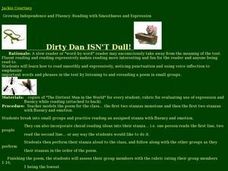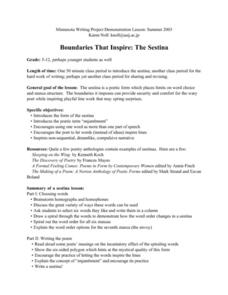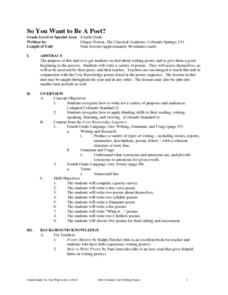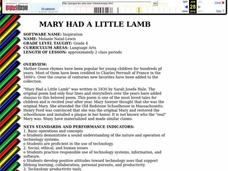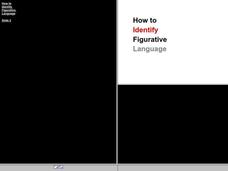Curated OER
Dirty Dan Isn't Dull!
Students read smoothly and expressively while noticing punctuation and using voice inflection to emphasize important words and phrases in the text. They listen to and reread a poem in small groups. Students discuss how the poem sounds...
Curated OER
Boundaries That Inspire: The Sestina
Students study the poetic term "enjambment". They use one word as more than one part of speech and let words (instead of ideas) inspire lines and non-sequential, dreamlike, compulsive narrative.
Curated OER
The Witch of Goingsnake
Students complete literary analysis and writing activities using The Witch of Goingsnake. In this literary analysis lesson plan, students interpret a proverb, read poems, complete a quaker reading, and complete research for the lesson...
Curated OER
Courage comes in all sizes: King Day
Third graders create a cinquain poem in groups about philanthropy and heroes. In this heroes lesson plan, 3rd graders review characteristics of heroes and how they demonstrate justice, kindness, and contribute to the common good. Then...
Curated OER
Language Arts: Creative Writing Devices
Eighth graders review sound and rhythm devices and apply them to their own writing exercises. Next, they interpret the poem, "Where I'm From," as an example of a personal narrative. Using their understanding of poetic devices, they...
Curated OER
So You Want to Be A Poet?
Fourth graders study different types of poetry and then write examples in this unit. They write, among others, free verse, Diamante, Clerihew, and color poems.
Curated OER
The Witch of Goingsnake
Students identify figurative language in a proverb and write an interpretation of the proverb prior to reading The Witch of Goingsnake. In this The Witch of Goingsnake lesson, students read a native American proverb and determine whether...
Curated OER
Food Chain Chant
Students memorize a poem using various reading strategies to reinforce the concept of the food chain and the terminology associated with it.
Curated OER
The Tabloid Ballad
Students explore the poetic ballad. They examine the rhythm of a typical ballad and listen to recitations of sample ballads. They choose an article from a supermarket tabloid and write a comical ballad using rhythms and structures...
Curated OER
Mary Had A Little Lamb
Fourth graders listen and observe the role play of the various versions of the poem. They take notes while listening and observing and develop their own versions of "Mary Had a Little Lamb".
Ereading Worksheets
Figurative Language for Edgar Allen Poe
Are your classes weary of dreary worksheets? Are the learners nearly napping? Thrill them, fill them with delight with an interactive worksheet that asks them to identify the figurative language Edgar Allen Poe uses to add horror and...
Curated OER
Chasing Metaphors
Students use metaphors in order to see commonly experienced objects, events, and people in new and more meaningful ways.
Curated OER
Look Again: Revising
Fifth graders read "Jabberwocky," as an example of revision. They practice revising their own work.
Beatrice Public Schools
Analogy Practice Worksheet
Clarify word relationships and practice working with synonyms and antonyms by administering an extensive worksheet. Class members determine the relationship between words and complete a series of analogies. Before assigning these...
Curated OER
Silent Stories
Students create a pictorial narrative based upon John Keats' "Ode on a Grecian Urn" and the Japanese techniques of "lacquer jar" stories in this three-day Language Arts/Art lesson.
Curated OER
Digital Storytelling Lesson Plans Bring Stories to Life
Students can use technology to enhance and improve their stories using digital storytelling lesson plans.
Curated OER
Paul Revere's Ride
Fifth graders investigate the life of Paul Revere. They compose a timeline of some of the major historical events leading to the American Revolution. The purpose of the ride is the focus of the lesson and the information is later...
Curated OER
Homophones and Vivid Verbs
Students define and practice using synonyms, antonyms, homonyms, and homophones in complete sentences, paragraphs and essays. They include "vivid verbs" in their writing with the aid of a dictionary or thesaurus.
Curated OER
Using Rock to Teach Literary Devices: Jimi Hendrix “The Wind Cries Mary”
Students explore literary elements through music. In this figurative language activity, students examine imagery and personification in "The Wind Cries Mary" by Jimi Hendrix.
Curated OER
How To Identify Figurative Language
Students investigate writing techniques by analyzing a chart. In this figurative language lesson plan, students define similes, metaphors and identify the difference between them and personification. Students demonstrate their...
Texas Education Agency
Texas Gateway: How to Read and Analyze a Poem (English Iii Reading)
This lesson focuses on strategies for reading and analyzing a poetry. Reading poetry creates some interesting challenges because a poem uses lines and stanzas rather than paragraphs in order to create emotions and experiences. Figurative...
Library of Congress
Loc: Poetry 180: Eagle Plain
A poem about the eagle is shared within six, three-line stanzas. The poem allow the reader to look at the American symbol in a different way.
Library of Congress
Loc: Poetry 180: End of April
A poem about a baby bird, emerging from its shell, is shared within the five, three-line stanzas.
Ted Nellen
Cyber English (By Ted Nellen): Stanza
This is a glossary entry for "Stanza" including the definition of the term.


